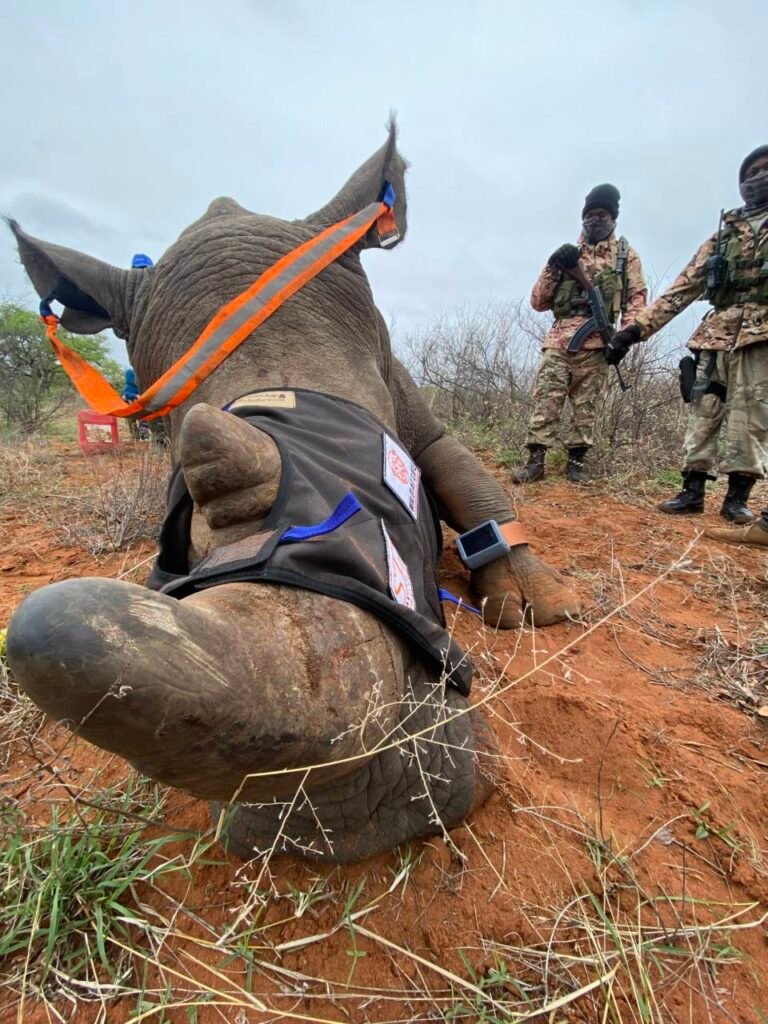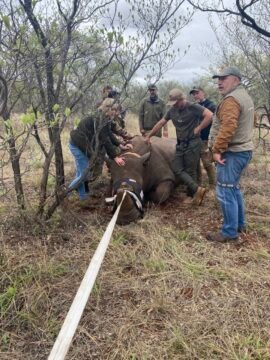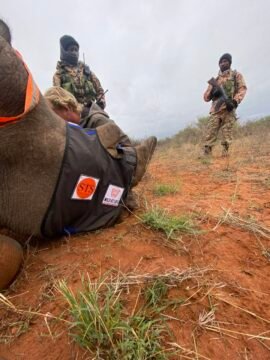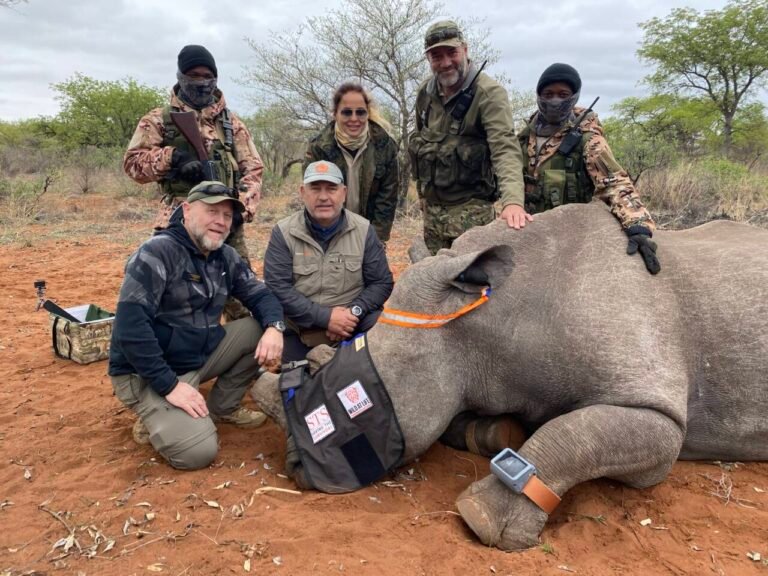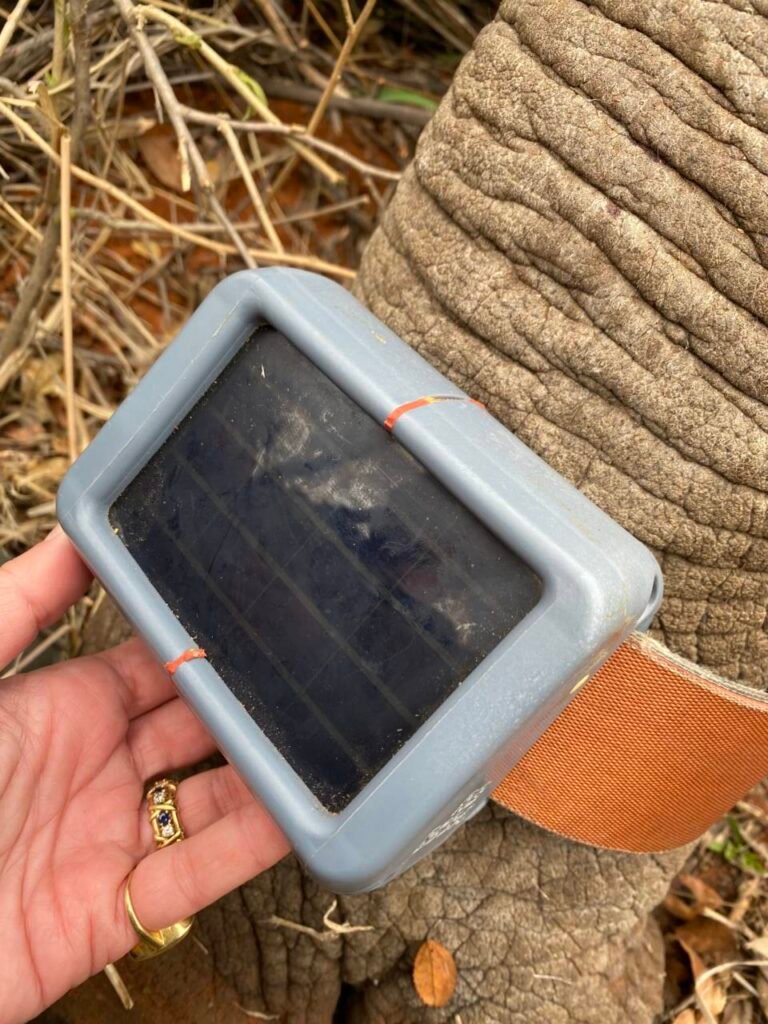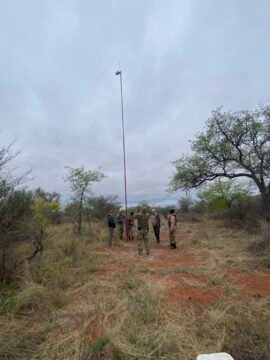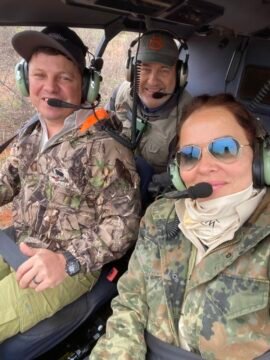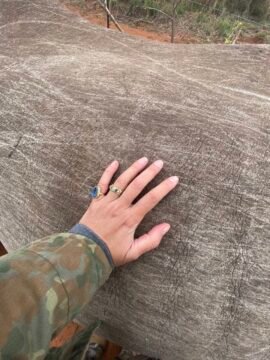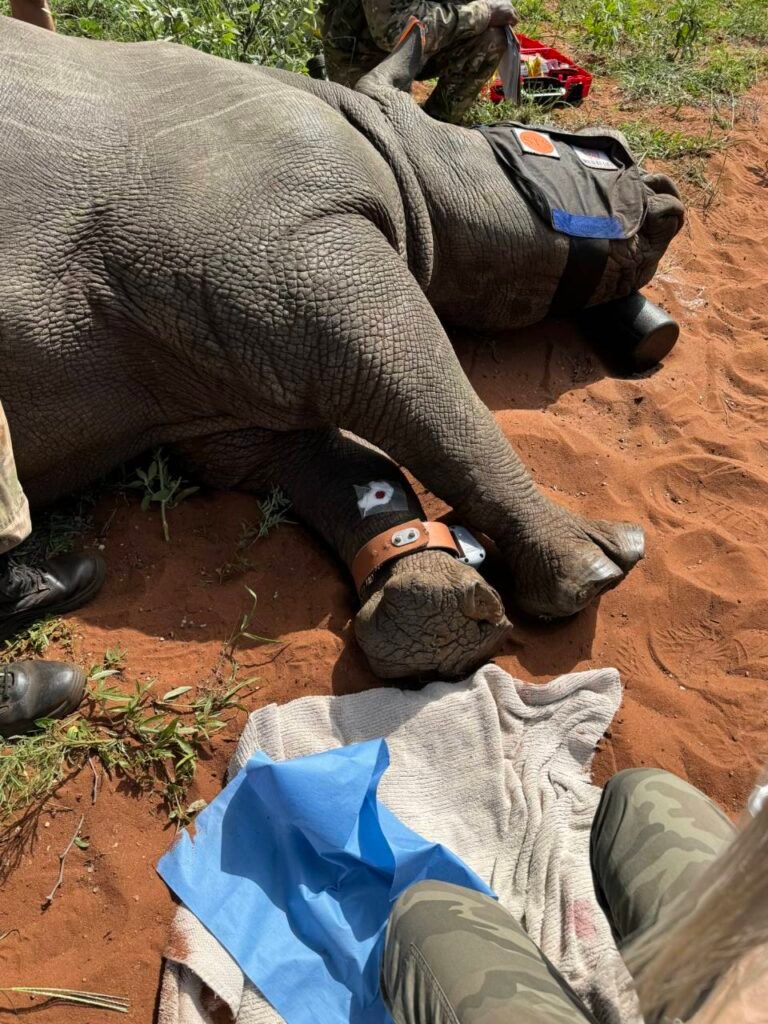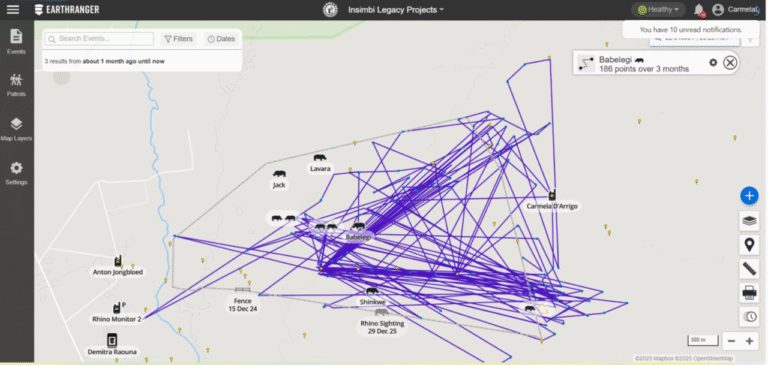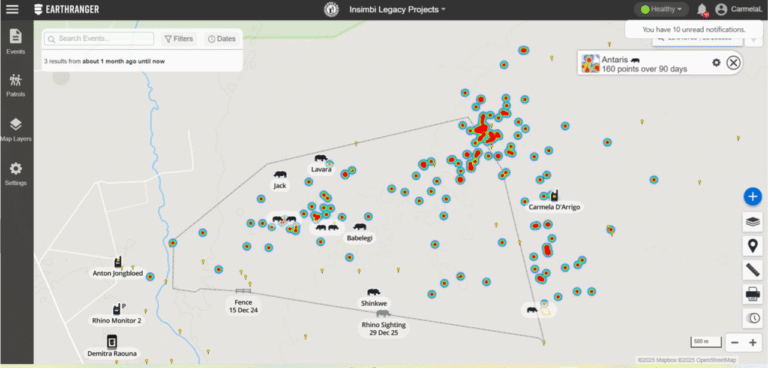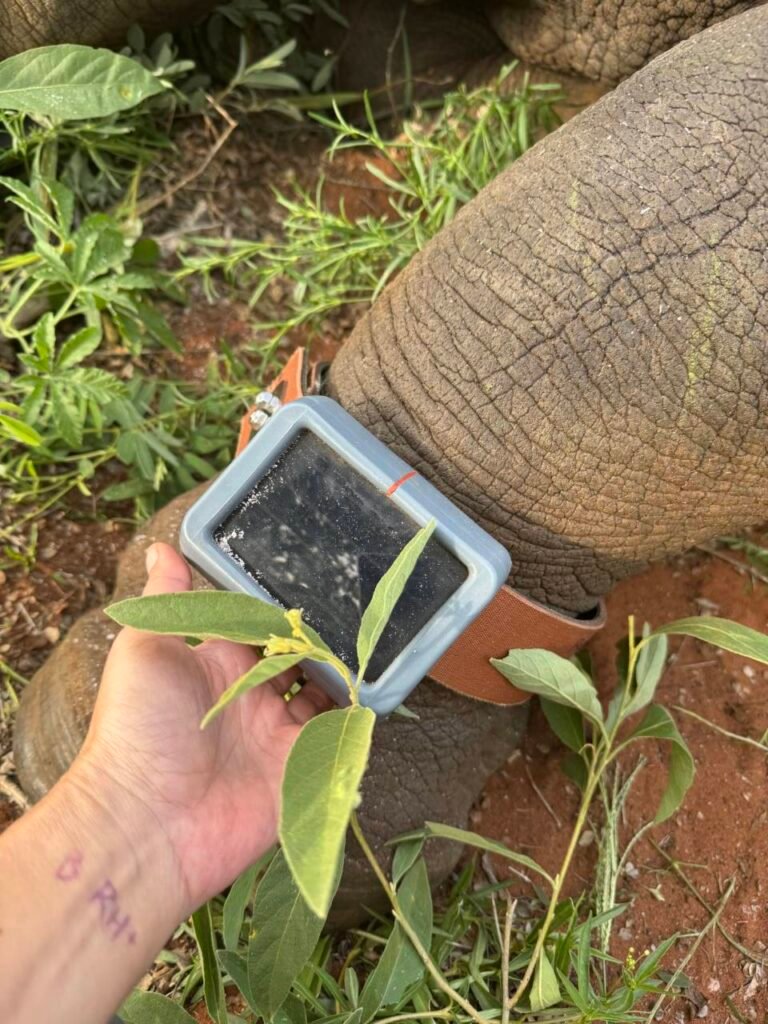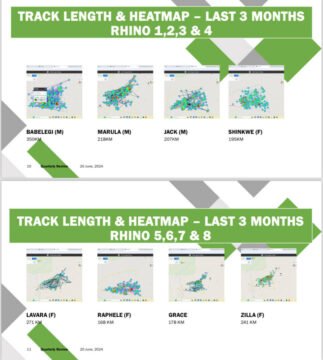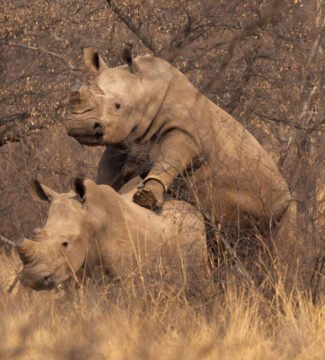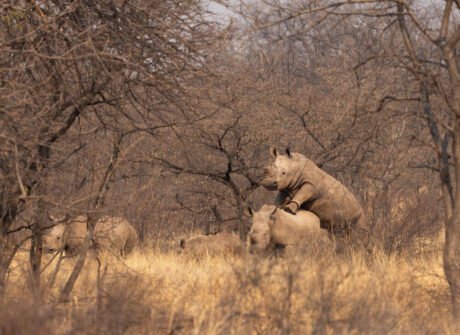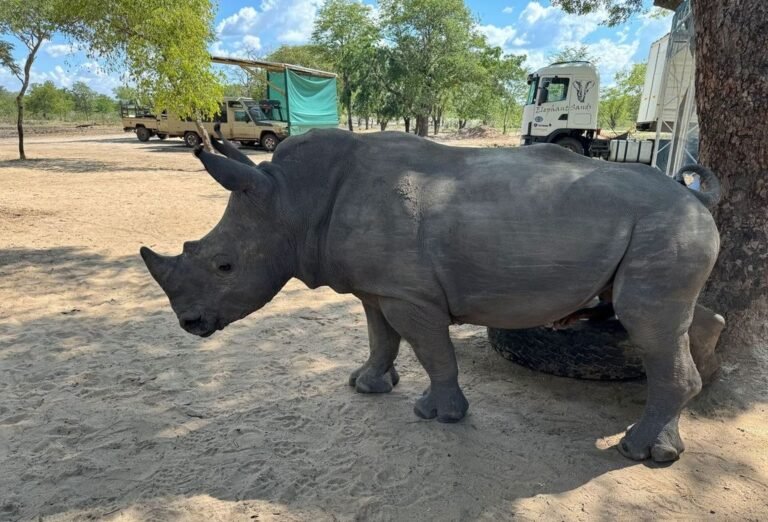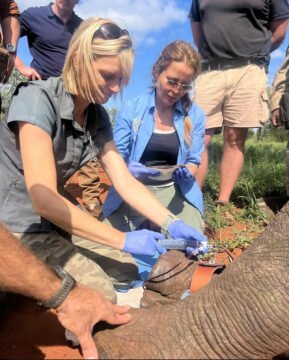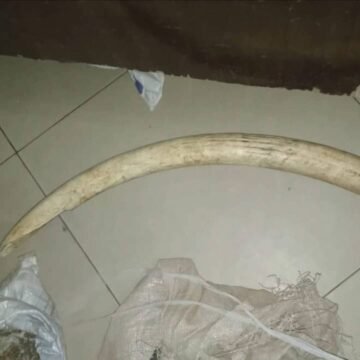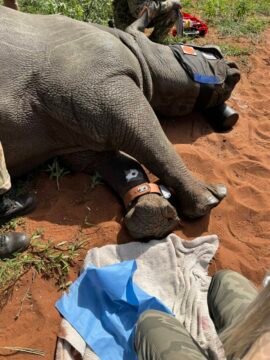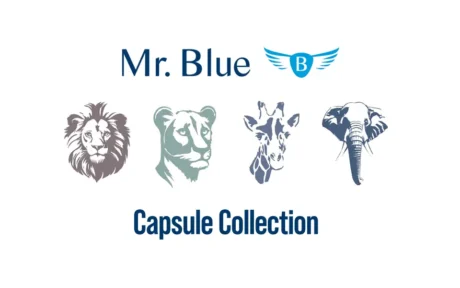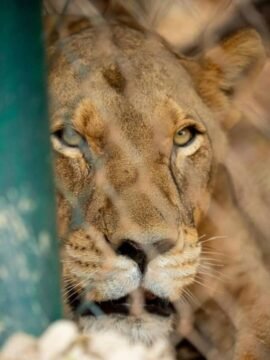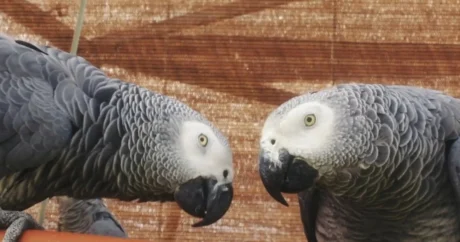A rhinoceros is a large herbivorous mammal known for its thick skin and one or more horns on its snout. There are five species: Black, White, Indian, Javan, and Sumatran.
Wild At Life Project
Rhinoceros Conservation and Rescue
Activity status: Ongoing
Area of Activity: South Africa
Rhino poaching remains a critical issue, especially in South Africa, which is at the heart of this crisis. In 2023 alone, 586 rhinos were killed across Africa, equating to one rhino poached every 15 hours. The primary reason for this is the high value of rhino horns on the black market, driven by false beliefs in their medicinal properties and their status as symbols of wealth, particularly in parts of Asia. This is why Wild at Life e.V. is advancing rhino conservation through innovative strategies. By using AI-powered tracking collars, we can monitor rhino movements in real-time to enhance their protection. Additionally, we collect plasma samples for medical treatments and safely trim their horns to reduce poaching risks. Our mission, which began in South Africa last October, marks a significant step in safeguarding these endangered and majestic animals.
Rhino protection and conservation efforts can be dangerous due to various factors. Conservationists and anti-poaching patrols may encounter armed poachers, leading to confrontations. Additionally, the vast areas where rhinos live can also present challenges. Harsh terrain, unpredictable wildlife, and sometimes political instability in the regions can complicate efforts.
Despite these challenges, conservation organizations like Wild at Life e.V., work to implement effective strategies and prioritize the safety of those involved in protecting rhinos.
With the funds raised, Wild at Life e.V. was able to set up a base station and collar four out of ten rhinos with AI-tracking collars. This is the latest technology and compared to GPS collars, is lighter, cheaper, and functions over a longer period of time. The rhinos can even be tracked via our smartphones!
Collaring is of paramount importance. It
- combats anti-poaching efforts by helping conservationists monitor the movement of rhinos in real-time. This information is crucial for identifying and responding to potential poaching threats, allowing for quicker intervention to protect the rhinos.
- valuable data on rhino behaviour, migration patterns, and habitat use. This information helps conservationists develop effective strategies for habitat protection, management, and anti-poaching efforts.
- contributes to population management by helping conservationists understand the demographics of rhino populations, including birth rates, mortality rates, and population distribution. This information is essential for making informed conservation decisions.
In our unwavering commitment to the conservation of rhinoceros populations, Wild at Life e.V. is constantly exploring innovative approaches to rescue and protect these magnificent creatures.
For instance, we are considering the potential of blood and plasma transfusions between rhinos. In the event that one rhino suffers severe injuries from poaching, the transfusion of blood or plasma from a healthy rhino could prove instrumental in its recovery. This ground-breaking initiative not only exemplifies our dedication to finding novel solutions but also underscores the interconnectedness of these remarkable animals.
Check out what happened that day in this YouTube video.
Stay tuned for our second collaring mission which will be carried out in January 2024!
Update: June 21, 2025
Progress Update: Rhino Conservation at Insimbi Legacy Reserve
The rhino conservation of Wild at Life e.V. and Insimbi Legacy Projects continues to strengthen efforts to protect White Rhinos in the Limpopo region of South Africa. Operating on a 5,000-hectare reserve in the Capricorn District, this joint mission combines veterinary intervention, real-time monitoring, and advanced security strategies to safeguard one of Africa’s most iconic and endangered species.
Our long-term work focuses on real-time wildlife tracking, anti-poaching infrastructure, and essential veterinary care for rhinos under constant threat.
Since the inception of the partnership in late 2023, a total of 10 white rhinos have been fitted with advanced AI-powered GPS collars. These collars enable continuous monitoring of each rhino’s movements, helping identify preferred territories and behavioral patterns, while enhancing anti-poaching operations.
Project Timeline & Milestones
-
September 2023: Project inception, initial field assessments and preparation for GPS collaring.
-
October 2023: First set of white rhinos collared with AI-powered GPS devices.
-
October 2024: Major storm damages one gateway tower; repairs completed using reserve’s own resources.
-
Q4 2024 (October–December):
Six out of nine collars transmitting effectively.
-
Field teams conduct quarterly data analysis using Earth Ranger.
-
Six out of nine collars transmitting effectively.
-
Rhino Raphele gives birth to a healthy calf, Rapula.
-
-
February 2025: New collar successfully deployed on Marula to replace malfunctioning unit.
-
Q1 2025 (January–March):
-
Six gateway towers fully operational.
-
New Rhino Monitoring & Volunteer Coordinator hired.
-
Improved field communications established with updated radio system.
-
Key Conservation Actions
- GPS Collaring & Monitoring
A total of 9 rhinos were collared between Q4 2023 and Q1 2025. Each collar transmits live location data, enabling heat map analysis and early response to unusual movement. The collars have allowed us to identify behavioral ranges, alerting rangers if animals stray near perimeter zones. -
Notable Individual Monitoring
-
Antares covered over 193 km between January and March 2025, primarily in the northeast zone.
-
Lavara showed one of the widest ranges at over 330 km, highlighting expansive territory usage.
-
Raphele, a female with a calf, stayed closer to water and safety zones, traveling only 45 km.
-
-
Security Enhancements
-
Earth Ranger tech is used to map movements and detect threats in real time.
-
Improved patrol coordination ensures protection of rhinos near boundary zones.
-
New volunteer and monitoring personnel on site since Q1 2025.
-
Tower network and GPS infrastructure maintained continuously.
-
Challenges & Responses
-
Collar Wear & Malfunction:
Some collars detached or failed due to hardware limits; replacements were swiftly implemented. -
Infrastructure Damage:
Extreme weather affected tower infrastructure in late 2024. We acted rapidly to restore full functionality. -
Communication Limitations:
Poor mobile reception remains a challenge. We now rely on two-way radio systems for real-time coordination in the field.
Outlook & Impact
With the successful collaring and monitoring of rhinos, including new births like Rapula, we are moving toward more predictive, preventive protection. By combining veterinary expertise, cutting-edge tech, and committed on-the-ground presence, Wild at Life and its partners continue to secure the future of rhinos in conflict-prone regions.
As we expand this work, continued funding and global support remain essential. These months have shown that in even the most remote and insecure areas, conservation is possible when technology, teamwork, and compassion align.
We Need Your Help
Protecting rhinos is a race against time. Every collar fitted, every patrol dispatched, and every tower maintained plays a vital role in keeping these magnificent animals safe. But none of it is possible without your help.
Please consider making a donation to our efforts. Even a small contribution can fund a patrol shift, repair vital equipment, or provide care for an injured animal.
Huge Success For Species Conservation
We are very happy to announce a big Win for the Victoria Falls Anti-Poaching Unit Team last week as 5 suspects were arrested with Ivory, pangolin scales andsnares!
Our growing informer network is reaping fantastic rewards leading to anexcellent arrest.
Information was obtained of individuals in possession of illegal wildlifecontraband and our teams immediately jumped into action.
A game of cat and mouse ensued ending with a sting operation which resulted inthe arrest of 5 suspects, the recovery of a piece of ivory, over 300 pangolinscales as well as 17 heavy duty cable snares.
These arrests mark a huge win for conservation in our area.
Massive thanks to the Police Minerals Flora and Fauna Unit as well as theNational Parks Investigations Team for the hard work and late hour operations.
We are committed to the safeguarding and preservation of our natural world andare confident that the maximum penalty will be issued to these culprits.
Update: October 25, 2024
Can We Save Rhinos from Poaching Before It’s Too Late?
Rhino poaching is still a major problem, especially in South Africa, which is at the center of this crisis. In 2023 alone, 586 rhinos were killed across Africa, which means a rhino was poached every 15 hours. The main reason rhinos are targeted is for their horns, which are highly valued on the black market. Many people believe rhino horns have medicinal properties, particularly in parts of Asia, even though there’s no scientific proof to support this. In addition, the horns are seen as symbols of wealth and status, driving up demand and increasing poaching.
While some areas have made progress in fighting poaching, the numbers are still rising in other places, putting even more pressure on rhino populations. White and black rhinos are the most affected species, with their numbers continuing to drop, especially in countries like South Africa and Namibia. The illegal trade of rhino horns is threatening their survival, and without strong intervention, these majestic animals could face extinction.
Our Conservation Efforts
During our last two missions, we have implemented various effective strategies to prevent poaching.

We deploy cutting-edge, non-invasive AI-powered tracking devices on the rhinos. These collars are working extremely well, allowing us to monitor their movements in real-time. In the picture, you can see the tracking data showing the movement patterns of the rhinos over the past three months. This helps us quickly detect any potential threats and adjust our patrols as needed.

Additionally, during these missions, we collected plasma samples from the rhinos. This process is not merely a routine procedure; it plays a vital role in the conservation and protection of these endangered animals. Plasma samples contain essential components that can be used in various medical treatments, offering a lifeline to rhinos in distress, especially those affected by poaching and other traumas.

Another critical way we protect rhinos is by trimming their horns. This procedure is simple and painless, akin to cutting nails or hair, ensuring that the well-being of the animals is prioritized. By shortening their horns, we effectively reduce their attractiveness to poachers, who seek rhinos primarily for their horns, which are highly valued in illegal markets for their perceived medicinal properties and as status symbols.
Community Engagement and Education
We recognize the importance of involving local communities in conservation efforts. By raising awareness about the value of rhinos and offering alternative livelihoods, we aim to reduce the incentive for poaching. Education programs can change public perceptions, helping to decrease demand for rhino horns.
The Impact of Our Efforts
The combination of tracking technology, ranger support, plasma collection, and horn trimming has significantly contributed to the safety and conservation of these magnificent creatures. We believe that our rhinos are relatively safe from poaching due to these combined efforts, allowing us to focus on their well-being and protection.
How You can Help
Your support would immensely help our mission to protect rhinos. Contributing to our fundraiser or choosing a symbolic adoption allows us to cover essential costs, including medical treatments and tracking technology. Together, we can make a significant impact on rhino conservation and ensure a safer future for these incredible animals. Thank you for your support!
Update: September 22, 2024
Join Us in Celebrating World Rhino Day
At Wild at Life e.V., we are dedicated on rhino conservation across the African continent, combining cutting-edge technology with community-driven efforts to protect one of the planet’s most iconic species. Our approach empowers local communities to take an active role in conservation, ensuring that those who live closest to these majestic animals are also their protectors. We recognize that the key to long-term success lies in engaging local populations, who are crucial allies in preserving rhino habitats and reporting poaching threats.
In the past 10 months, we have launched two vital missions and equipped 10 rhinos with state-of-the-art, AI-powered tracking devices supported by satellite poles. These devices provide real-time data on rhino movements, helping us monitor habitats, identify migration routes, and protect critical areas. This technology is essential in combating poaching, allowing us to quickly detect and respond to potential threats.
Alongside these innovations, we implement hands-on interventions, such as collecting plasma samples from rhinos to create life-saving reserves for those who survive poaching attacks. We also trim rhino horns to deter poachers, making the animals less attractive targets. Together, these efforts significantly reduce poaching incidents and improve rhino survival rates in high-risk areas.
We would be incredibly grateful for your support! By donating to our ongoing fundraiser or symbolically adopting a rhino, you can play a vital role in our conservation efforts. Thank you for making a difference!
The Plight of Rhinos
Despite ongoing conservation efforts, we are at a critical turning point for rhinos. Their populations continue to decline due to poaching, habitat loss, and weak law enforcement. Since the early 1900s, rhino numbers have plummeted from around 500,000 to approximately 27,000 today, with over 1,000 rhinos poached in South Africa alone in 2017. This crisis is fueled by demand for rhino horns in traditional medicine and the illegal wildlife trade.
Habitat loss from agricultural expansion and urbanization further threatens their survival. Rhinos need vast territories for grazing and breeding, and as their habitats shrink, their populations decrease. The situation is particularly dire for the Northern white rhino, which is functionally extinct, with only two females remaining, leading to a critical loss of genetic diversity essential for the species’ resilience.
If current laws remain lax and perpetrators of wildlife crimes go unpunished, the rhinos we’ve fought so hard to protect will disappear from the African continent. We must urgently advocate for stronger laws, harsher penalties, and more rigorous enforcement. Without immediate action, not only will we lose these magnificent creatures, but we will also diminish the biodiversity that supports our ecosystems.
We would be incredibly grateful for your support! By donating to our ongoing fundraiser or symbolically adopting a rhino, you can play a vital role in our conservation efforts. Links are provided below. Thank you for making a difference!
Update: April 29, 2024
Rhino Orphans: Victims of Poaching
Meet Dos
Rhinos face a constant threat: poaching for their horns. Behind each poached rhino lies a tragic consequence—their orphaned calves. Without their mothers, these vulnerable calves face danger and emotional distress.
📍Zambia

We would like to introduce you to Dos, our most recent rescue.
Tragically, her mother fell victim to poachers, leaving Dos orphaned at a young age.
It’s typical for rhino calves to stay with their mothers until they’re about three years old, but Dos’s life took a different path when her mother was taken from her. Helpless and unprotected little Dos would have faced certain death but luckily we found her just in time.
It is heartbreaking to see her grow up without her mother but we are making sure that she will be safe from now on.
From the moment of her rescue, we’ve been in constant communication with reserves, seeking the best possible future for this precious creature.
Update: March 17, 2024
Safeguarding Rhinos through Conservation Efforts
The poaching crisis facing rhinos, driven by the demand for their horns, is a devastating reality. Each year, hundreds fall victim to this illegal trade, with their horns sought after for perceived medicinal and ornamental purposes.
Our organization is dedicated to combating this tragedy through innovative measures. We employ AI-powered tracking devices, allowing us to monitor their movements and swiftly respond to any threats. Additionally, we collect plasma samples to create a comprehensive database, aiding in the identification and protection of individual rhinos. By leveraging technology and scientific advancements, we strive to keep these magnificent creatures safe from harm, preserving their populations for future generations to admire and cherish.
AI-Powered Tracking Devices

We use AI-powered tracking devices for rhinos to monitor their movements and behaviors for several crucial reasons. Firstly, these devices help us to understand their habitat preferences, migration patterns, and daily routines, which are vital for effective conservation strategies. By collecting data on where they roam, we can identify key areas for protection and ensure they have access to suitable habitats.
Secondly, these devices serve as a powerful tool against poaching. With real-time tracking capabilities, we can swiftly respond to any suspicious activity or threats to the rhinos’ safety. This allows law enforcement and conservation teams to intervene promptly, potentially saving lives and deterring poachers.
Moreover, the data collected from these devices provides invaluable insights into rhino health and well-being. We can monitor factors such as stress levels, activity levels, and social interactions, aiding in the early detection of illness or injury. This proactive approach to monitoring their health helps us to provide timely medical intervention when needed, ultimately contributing to their overall survival and reproductive success.
Plasma Samples

We collect plasma samples from rhinos as part of a unique and innovative approach to conservation and anti-poaching efforts. These plasma samples serve a critical purpose: they become a lifeline for rhinos who may fall victim to poaching in the future.
When a rhino is poached, its horn is brutally removed, often leaving the animal to bleed to death.
This means that the rhino whose plasma we collected becomes a blood donor for their fellow rhinos in need. When a rhino is poached and survives the ordeal, each plasma donor rhino becomes a potential savior for their kind, offering a second chance at life to those who have suffered at the hands of poachers.
Why do we Trim the Horns?
The answer lies in disrupting the illegal trade that fuels poaching. Rhino horns are highly sought-after commodities, fetching exorbitant prices on the black market. By preemptively trimming the horns under controlled, safe conditions, we remove the incentive for poachers to target these animals. Without their horns, rhinos become less attractive targets, reducing the risk to their lives.
Moreover, trimming the horns is a proactive approach to safeguarding their well-being. Poachers often resort to brutal methods, including tranquilizer overdoses or even hacking off horns while the rhinos are still alive. This barbaric practice not only causes immense suffering but also poses grave risks to the rhinos’ health and survival.
By trimming the horns safely and humanely, we eliminate the need for rhinos to endure the trauma of poaching attempts. It’s a preventative measure that aims to keep these animals safe, healthy, and thriving in their natural habitats. Additionally, the removed horns are often stockpiled or marked with indelible dye, making them worthless on the black market.
In the video below, we see the devastating effects of rhino poaching. It exposes the brutal reality of poaching and shows our organization’s efforts to fight against it. You can also see us in action deploying the tracking devices on the rhinos as well as collecting plasma samples.
This project is carried out in the following activity areas
Spread the news!
Help us increasing social commitment in saving endangered wild species. Express your support by sharing this article in your favorite social media channel.
Facebook
Twitter
LinkedIn
Pinterest
WhatsApp
Email
Most recent news
Project update
June 30, 2025
Recently, the Victoria Falls Anti-Poaching Unit achieved a significant success with the arrest of five suspects found in possession of illegal wildlife contraband, including ivory, pangolin scales, and snares. Thanks to our expanding informer network, crucial intelligence was quickly acted
Project update
June 21, 2025
The rhino conservation of Wild at Life e.V. and Insimbi Legacy Projects continues to strengthen efforts to protect White Rhinos in the Limpopo region of South Africa. Operating on a 5,000-hectare reserve in the Capricorn District, this joint mission combines
News
June 2, 2025
Wild at Life is a dedicated wildlife conservation NGO working tirelessly to protect endangered species and their habitats. With a focus on combating wildlife trafficking, ending canned hunting, and preserving biodiversity, Wild at Life’s mission is to create a world
Project update
April 27, 2025
A few years ago, together with our partner, the Association for the Protection of Fauna and Flora, we conducted a distressing investigation at a zoo in Burkina Faso. The 112-hectare site was home to numerous endangered species, many of them
News
April 9, 2025
This article reports on the successful repatriation of 34 African Grey Parrots that were illegally smuggled from Africa to Spain. The parrots were intercepted in Spain, and Turkish Cargo facilitated their transportation back to their natural habitats free of charge.
News
April 9, 2025
The article details the rescue and repatriation of 34 African Grey Parrots that were illegally trafficked from Africa to Spain. In collaboration with Turkish Cargo, which provided complimentary transportation, and various international organizations—including Wild at Life e.V., the Spanish Ministry
Stay informed!
Subscribe to our newsletter to keep up to date with our activities!
By subscribing you consent to our Privacy Policy
